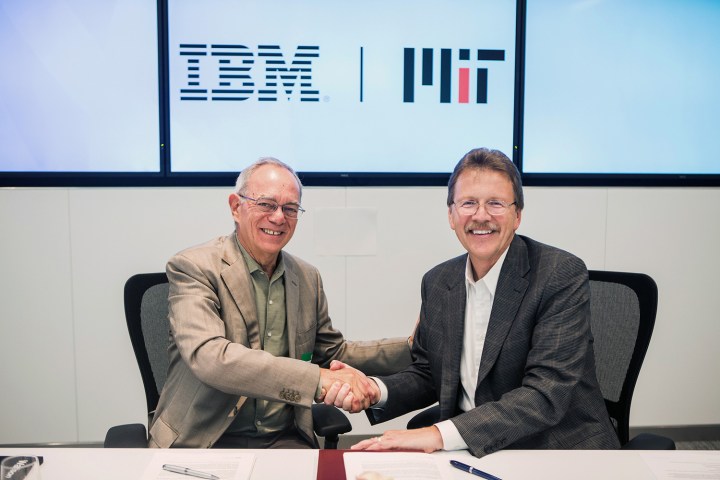
A.I. is rapidly becoming a major focus of modern technology, and its importance to our everyday lives will only increase over the next few years. IBM and MIT both want to be on the forefront of the latest developments – but this partnership goes far beyond the technology itself.
The lab will consider the societal impact of A.I. alongside its efforts to push the technology forward. The idea is not just to explore what’s possible, but also make sure that the cutting edge doesn’t cut too deep.
The Four Pillars
MIT and IBM are committed to keeping an open mind. Not every idea will be followed up, but all kinds of pitches are welcomed. So far, the two organizations have established four main pillars that will guide future research.
The first is core algorithmic advances, with a focus on ensuring the development process is more transparent than it is today. IBM’s vice president of A.I., Dario Gil, told Digital Trends that the intent is to move away from the “black box” model, which obfuscates much A.I. research today, and make it more understandable from an outside perspective.
Then there’s work on what IBM and MIT refer to as the physics of A.I. — the hardware that will be used to take the technology to new heights. Another strand of research will look at potential practical applications for A.I. across various industries.
Finally, there’s the broad topic of “shared prosperity.” This branch of study will investigate how researchers can stop A.I. and automated labor from leaving the human workforce behind, or otherwise have a negative impact on the average person’s economic future.
Now is the time to look at A.I. from all angles, because the major advances that have been made in recent years are soon going to have a direct impact on our lives.
From I.T to A.I.
In the 1980s and 1990s, the rise of the personal computer transformed our homes and workplaces. IBM hopes that A.I. could do the same. .
Gil takes the stance that A.I. is the new I.T., in that it will soon become ubiquitous across all industries and organizations, impacting how people work and live even if they’re not directly engaged with it. He points to the relatively rapid adoption of computers over the last few decades, and how quickly it became an accepted fact that any modern business needed to take advantage of modern technology. I.T. departments became commonplace. Computer science emerged as a discipline. He sees a similar path forward for A.I.
“Every business on earth is going to start thinking, ‘well, how do I deploy A.I.?’”
“Every business on earth is going to start thinking, ‘well, how do I deploy A.I.?’” he said. “Just like with I.T. ‘How am I going to use it to solve problems that I couldn’t solve before?’”
He cites the number of students taking the Introduction to Machine Learning Course at MIT. Three years ago, 200 students registered for the course; this year, over 700 students have registered, the record for any class in terms of demand. Stanford’s Introduction to Machine Learning class has also set records this year, with 1,080 students signed up.
Many smart young people are looking to put their talents to use in the field of A.I. – and when they graduate in a few years’ time, they’ll be working with hardware that’s even more advanced than the best we have today.
Playing with Power
If you look at some of the algorithms that everybody’s using today that’s got everyone excited, like deep learning – those algorithms are not new,” explained Gil “Those algorithms have been with us for many decades, actually.” According to him there are two factors holding back A.I. development — the computational power we have access to, and the amount of digital data we have on hand to train these neural networks with.
“Computational power is at the center of the A.I. action today,” he added. “And it’s going to remain so for many, many years to come.”

Training large models requires a huge amount of data, and remains a costly, often inefficient process. Over the next decade we could make improvements in this respect, but it’s going to require better hardware. In the short-term, Gil projects that we’re going to establish new architectures that are based upon existing silicon technology. Beyond that, researchers are considering analog A.I. that abandons today’s silicon transistors and introduces memory-like elements into the computation process.
This work is undeniably promising, but it’s a simple evolution of the hardware we have today. Another, more dramatic option is the use of a quantum computer to explore the potential of an A.I. Such research is still in its earliest conceptual stages, but the enormous computational power of a large-scale universal quantum computer seems likely to inspire a major leap in our understanding.
MIT’s lab will have access to IBM Q, the company’s flagship quantum project. Recently updated to a 20-qubit processor, an even more impressive 50-qubit version on the horizon – hardware that will surely be a real gamechanger when it’s possible to use it to its full potential. This avenue of research is set to be a two-way street. Machine learning will be used to help advance research into quantum hardware, and the results will help scientists push the boundaries of machine learning.
Safe Passage
“We’re motivated to make technology that solves problems for the world,” explained Gil. “For me as a leader, it’s very important that we do it in the right way. To do it in the right way, you need to be thoughtful – you need to study these issues with rigor and seriousness.”
A.I. can be a force for good, but it also has the potential to cause great harm. We’ve already seen examples, such as bots used to harass people online. There’s also the capacity for collateral damage, like the people who will lose their jobs if automated machinery becomes the norm in various industries.
“We want to bring A.I. safely into the world”
“We are aware of the concerns surrounding AI and its future abilities – and that’s something anyone in this field must consider as they embark on new research,” wrote Anantha Chandrakasan, the dean of MIT’s school of engineering, in email correspondence with Digital Trends. “But we see the best path forward as exploring and understanding the risks and opportunities the future of AI might bring, and thereby, formulating scenarios about how to best respond to such concerns.”
“We want to bring A.I. safely into the world,” said Gil. To that end, the lab will see practitioners in the field collaborate with experts from various disciplines like economics and politics. It’s a matter of putting people who understand the technology inside-out in communication with people who are well-versed in the social issues that will occur.
“The kind of conversation that’s happening, broadly, in society is interesting, but it tends to be either utopia or dystopia,” Gil explained, referring to the dual fantasies of a future where no human has to work, and a doomsday where hyper-intelligent robots take over. “It’s the two extremes. The sophisticated, nuanced conversation of what we need to do, step-by-step, is often not encountered.”
The MIT-IBM Watson A.I. Lab will be the setting for these discussions. It’s clear that A.I. is bursting with potential, but that brings about its own challenges. Individuals and organizations working in the field are sure to want to use their talents to break new ground. Both MIT and IBM want to facilitate that important work – but they want to make sure that it’s carried out with the proper caution.
Editors' Recommendations
- IBM’s A.I. Mayflower ship is crossing the Atlantic, and you can watch it live
- Microsoft wants to use A.I. to make health care better for everyone
- Goodbye, tedious masks? A.I. is about to make Photoshop selections even faster
- A learning bias found in kids could help make A.I. technology better
- MIT and IBM’s new A.I. image-editing tool lets you paint with neurons


